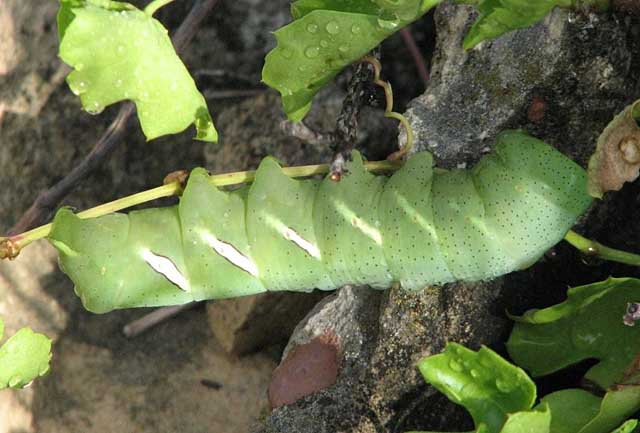
Manduca rustica, near Terlingua, Brewster County, Texas, July 30, 2008, courtesy of B. Wunderlich, the observer and photographer, via Phil Crosby, the submitter.
|
|
Dedicated/inspired by personal communication with Delyse Jaeger, June 22, 2009; December 2, 2010 Updated as per James P. Tuttle's The Hawk Moths of North America, December 2, 2010 |

Manduca rustica, near Terlingua, Brewster County, Texas, July 30, 2008, courtesy of B. Wunderlich, the observer and photographer, via Phil Crosby, the submitter.
This page is inspired by and dedicated to
Delyse Jaeger who sent me the
Eumorpha vitis image, top of this page.
Delyse writes, "We have attached an image of a caterpillar that we are having trouble identifying. We believe it belongs to the Sphinx family...What do
you think?"
Seventy-five Sphingidae species are listed for Texas on the U.S.G.S. website. Not all of the species are reported or anticipated in the west central region. It is hoped that this checklist, with the thumbnails and notes, will help you quickly identify the moths you are likely to encounter within the area bounded from Val Verde north to Ector, east to Coke and south to Kinney, northwest back to Val verde.
Please help me develop this list with improved, documented accuracy by sending sightings (species, date, location), preferably with an electronic image, via email to Bill Oehlke.
Sphinginae subfamily
Smerinthini Tribe:
Macroglossinae subfamilyDilophonotini tribe:
Philampelini tribe:
Macroglossini tribe:
|
Enjoy some of nature's wonderments, giant silk moth cocoons. These cocoons are for sale winter and fall. Beautiful Saturniidae moths will emerge the following spring and summer. Read Actias luna rearing article. Additional online help available.
Eggs of many North American species are offered during the spring and summer. Occasionally summer Actias luna and summer Antheraea polyphemus cocoons are available. Shipping to US destinations is done from with in the US.
Use your browser "Back" button to return to the previous page.
This page is brought to you by Bill Oehlke and the WLSS. Pages are on space rented from Bizland. If you would like to become a "Patron of the Sphingidae Site", contact Bill.
Please send sightings/images to Bill. I will do my best to respond to requests for identification help.
 Show appreciation for this site by clicking on flashing butterfly to the left. The link will take you to a page with links to many insect sites. |